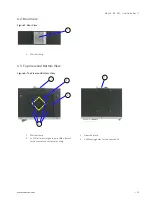
KBox A-150-SKL - User Guide Rev. 1.1
// 15
Electrostatic Discharge (ESD)
1.1.
A sudden discharge of electrostatic electricity can destroy static-sensitive devices or micro-
circuitry.
Therefore, proper packaging and grounding techniques are necessary precautions to prevent damage. Always take
the following precautions:
1.
Transport boards in ESD-safe containers such as boxes or bags.
2.
Keep electrostatic sensitive parts in their containers until they arrive at the ESD-safe workplace.
3.
Always be properly grounded when touching a sensitive board, component, or assembly.
4.
Store electrostatic-sensitive boards in protective packaging or on antistatic mats.
1.1.1.
Grounding Methods
By adhering to the guidelines below, electrostatic damage to the product can be avoided:
1.
Cover workstations with approved antistatic material. Always wear a wrist strap connected to workplace. Always
use properly grounded tools and equipment.
2.
Use antistatic mats, heel straps, or air ionizers for more protection.
3.
Always handle electrostatically sensitive components by their edge or by their casing.
4.
Avoid contact with pins, leads, or circuitry.
5.
Switch off power and input signals before inserting and removing connectors or connecting test equipment.
6.
Keep work area free of non-conductive materials such as ordinary plastic assembly aids and Styrofoam.
7.
Use only field service tools that are conductive, such as cutters, screwdrivers, and vacuum cleaners.
8.
Always place drives and boards PCB-assembly-side down on the foam.
Instructions for Lithium Battery
1.2.
The KBox A-150-SKL is equipped with a Kontron specific battery assembly and is not designed to operate without a
battery. If the battery is empty or disconnected, the BIOS settings will be set to the factory defaults. To replace the
battery, observe the instructions described in Chapter 14.3.1: Replacing the Lithium Battery.
Danger of explosion when replacing with wrong type of battery. Replace only with the same
or equivalent type recommended by the manufacturer. The lithium battery type must be UL
recognized.
Do not dispose of lithium batteries in general trash collection. Dispose of the battery
according to the local regulations dealing with the disposal of these special materials, (e.g.
to collecting points for battery disposal).
















































